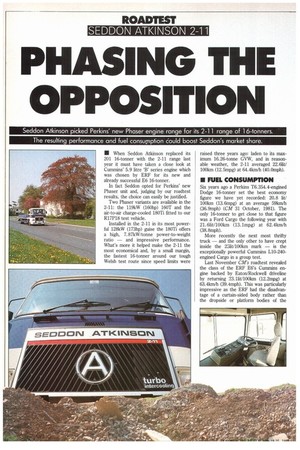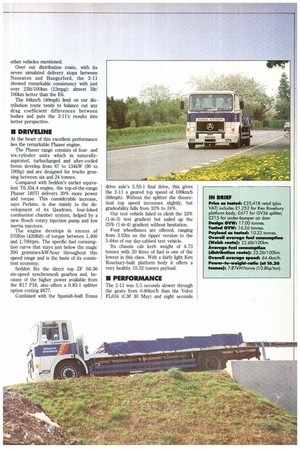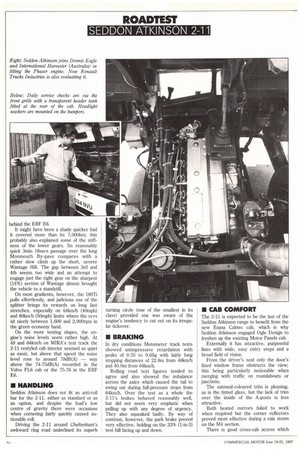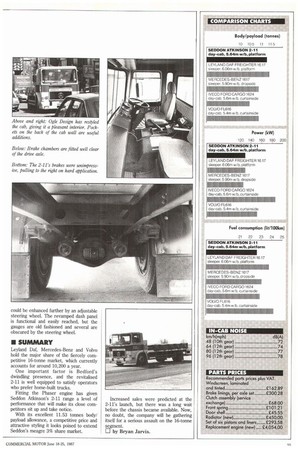PHASING THE OPPOSITION
Page 54

Page 55

Page 56

Page 57

If you've noticed an error in this article please click here to report it so we can fix it.
Seddon Atkinson picked Perkins' new Phaser engine range for its 2-11 range of 1 6-tonners. The resulting performance and fuel consumption Could boost Seddon's market share.
• When Seddon Atkinson replaced its 201 16-tonner with the 2-11 range last year it must have taken a close look at Cummins' 5.9 litre 'B' series engine which was chosen by ERF for its new and already successful E6 16-tonner.
In fact Seddon opted for Perkins' new Phaser unit and, judging by our roadtest results, the choice can easily be justified.
Two Phaser variants are available in the 2-11: the 119kW (160hp) 1601 and the air-to-air charge-cooled 180Ti fitted to our R17P18 test vehicle.
Installed in the 2-11 in its most powerful 128kW (173hp) guise the 180Ti offers a high, 7.87kW/tonne power-to-weight ratio — and impressive performance. What's more it helped make the 2-11 the most economical and, by a small margin, the fastest 16-tonner around our tough Welsh test route since speed limits were raised three years ago: laden to its maximum 16.26-tonne GVW, and in reasonable weather, the 2-11 averaged 22.6Iit/ 100km (12.5mpg) at 64.4km/h (40.0mph).
• FUEL CONSUMPTION
Six years ago a Perkins T6.354.4-engined Dodge 16-tonner set the best economy figure we have yet recorded: 20.8 lit/ 1001un (13.6mpg) at an average 59km/h (36.9mph) (CM 31 October, 1981). The only 16-tonner to get close to that figure was a Ford Cargo the following year with 21. 61it/100km (13.1mpg) at 62.4km/h (38.8mph).
More recently the next most thrifty truck — and the only other to have crept inside the 2Slit./100km mark — is the exceptionally powerful Cummins L10-240engined Cargo in a group test, Last November CM's roadtest revealed the class of the Ere E6's Cummins engine backed by Eaton/Rockwell driveline by returning 23.11it/100km (12.2mpg) at 63.41cm/h (39.4mph). This was particularly impressive as the ERF had the disadvantage of a curtain-sided body rather than the dropside or platform bodies of the
other vehicles mentioned.
Over our distribution route, with its seven simulated delivery stops between Nuneaton and Hungerford, the 2-11 showed remarkable consistency with just over 23lit/1001un (12mpg): almost Hit/ 100km better than the E6.
The 641(m/h (40mph) limit on our distribution route tends to balance out any drag coefficient differences between bodies and puts the 2-11's results into better perspective.
• DMVELINE
At the heart of this excellent performance lies the remarkable Phaser engine.
The Phaser range consists of fourand six-cylinder units which in naturallyaspirated, turbocharged and after-cooled forms develop from 67 to 134kW (90 to 180hp) and are designed for trucks grossing between six and 24 tonnes.
Compared with Seddon's earlier equivalent T6.354.4 engine, the top-of-the-range Phaser 180Ti delivers 20% more power and torque. This considerable increase, says Perkins, is due mainly to the development of its Quadram, four-lobed combustion chamber system, helped by a new Bosch rotary injection pump and low inertia injectors.
The engine develops in excess of 570Nm (4201bft) of torque between 1,400 and 1,700rpm. The specific fuel consumption curve that stays just below the magic 200 grammes/kW/hour throughout this speed range and is the basis of its consistent economy.
Seddon fits the direct top ZF S6-36 six-speed synchromesh gearbox and, because of the higher power available from the R17 P18, also offers a 0.83:1 splitter option costing £677.
Combined with the Spanish-built Enasa drive axle's 5.55:1 final drive, this gives the 2-11 a geared top speed of 109km/h (68mph). Without the splitter the theoretical top speed increases slightly, but gradeability falls from 32% to 24%.
Our test vehicle failed to climb the 33% (1-in-3) test gradient but sailed up the 25% (1-in-4) gradient without hesitation.
Four wheelbases are offered, ranging from 3.03m on the tipper version to the 5.64m of our day-cabbed test vehicle.
Its chassis cab kerb weight of 4.73 tonnes with 20 litres of fuel is one of the lowest in this class. With a fairly light Ken Rosebury-built platform body it offers a very healthy 10.32 tonnes payload.
• PERFORMANCE
The 2-11 was 5.5 seconds slower through the gears from 0-80km/h than the Volvo FL616 (CM 30 May) and eight seconds
behind the ERF E6.
It might have been a shade quicker had it covered more than its 7,000km; this probably also explained some of the stiffness of the lower gears. Its reasonably quick 3min 18secs passage over the long Monmouth By-pass compares with a rather slow climb up the short, severe Wantage Hill. The gap between 3rd and 4th seems too wide and an attempt to engage just the right gear on the sharpest (14%) section of Wantage almost brought the vehicle to a standstill.
On most gradients, however, the 180Ti pulls effortlessly, and judicious use of the splitter brings its rewards on long fast stretches, especially on 64km/h (40mph) and 80krn/h (50mph) limits where the revs sit nicely between 1,600 and 2,000rpm in the green economy band.
On the more testing slopes, the engine's noise levels seem rather high. At 48 and 64km/h on MIRA's test track the 2-11 restyled cab interior seemed as quiet as most, but above that speed the noise level rose to around 78dB(A) — way above the 74-75dB(A) recorded in the Volvo FL6 cab or the 75-76 in the ERF E6.
• HANDLING
Seddon Atkinson does not fit an anti-roll bar for the 2-11, either as standard or as an option, and despite the load's low centre of gravity there were occasions when cornering fairly quickly caused noticeable roll.
Driving the 2-11 around Cheltenham's awkward ring road underlined its superb turning circle (one of the smallest in its class) provided one was aware of the engine's tendency to cut out on its irregular tickover.
• BRAKING
In dry conditions Motometer track tests showed unimpressive retardation with peaks of 0.55 to 0.65g with fairly long stopping distances of 22.8m from 481un/h and 40.0m from 64km/h.
Rolling road test figures tended to agree and also showed the imbalance across the axles which caused the tail to swing out during full-pressure stops from 64km/h. Over the test as a whole the 2-11's brakes behaved reasonably well, but did not seem very emphatic when pulling up with any degree of urgency. They also squeaked badly. By way of contrast, however, the park brake proved very effective, holding on the 33% (1-in-3) test hill facing up and down.
• CAB COMFORT
The 2-11 is expected to be the last of the Seddon Atkinson range to benefit from the new Enasa Cabtec cab, which is why Seddon Atkinson engaged Ogle Design to freshen up the existing Motor Panels cab.
Externally it has attractive, purposeful lines with wide, easy entry steps and a broad field of vision.
From the driver's seat only the door's fixed window frame obstructs the view; this being particularly noticeable when merging with traffic on roundabouts or junctions.
The oatmeal-coloured trim is pleasing, as is the tinted glass, but the lack of trim over the inside of the A-posts is less attractive.
Both heated mirrors failed to work when required but the corner reflectors proved most effective during a rain storm on the M4 section.
There is good cross-cab access which could be enhanced further by an adjustable steering wheel. The revamped dash panel is functional and easily reached, but the gauges are old fashioned and several are obscured by the steering wheel.
• SUMMARY
Leyland Daf, Mercedes-Benz and Volvo hold the major share of the fiercely competitive 16-tonne market, which currently accounts for around 10,200 a year.
One important factor is Bedford's dwindling presence, and the revitalised 2-11 is well equipped to satisfy operators who prefer home-built trucks.
Fitting the Phaser engine has given Seddon Atkinson's 2-11 range a level of performance that will make its close competitors sit up and take notice.
With its excellent 11.53 tonnes body/ payload allowance, a competitive price and attractive styling it looks poised to extend Seddon's meagre 3% share market. Increased sales were predicted at the 2-11's launch, but there was a long wait before the chassis became available. Now, no doubt, the company will be gathering itself for a serious assault on the 16-tonne ent.
LI by Bryan Jarvis.




































































































